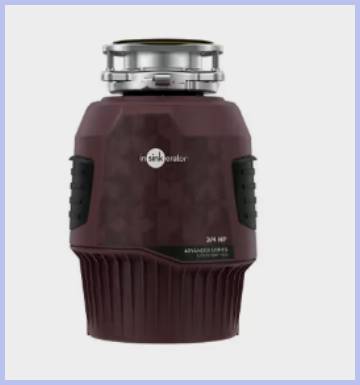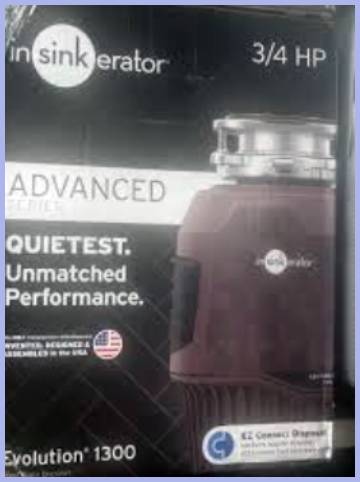If you’re in the market for a powerful and quiet garbage disposal, the InSinkErator Evolution 1300 is worth looking at.
I installed it in my kitchen and this review shares everything you need to know—from ease of setup to daily performance and long-term use.
By the end, you’ll know whether the Evolution 1300 is the right upgrade for your kitchen disposal needs.
My Experience Installing and Using the Evolution 1300

I replaced my old disposals—and I didn’t realize how far behind they were until I tried the Evolution 1300. From the moment I unboxed it, I could tell this was a premium unit.
It includes everything: EZ Connect hardwire adapter, plunger wrench, sink flange, gaskets, and even a dishwasher inlet plug.
The design looked well-thought-out and clearly built for hassle‑free installation.
Installation was easier than I expected. I reused my existing sink mount, snapped on the flange without plumber’s putty, and attached the disposal to the twist-on mount in under 10 minutes.
The hardwire adapter made wiring simple—no crawling under the sink into tight spots. Including the plumbing connections, it took me under two hours total.
Once powered up, the first impression was how quiet it runs. Even during full loads—potato scraps, celery stalks, and eggshells—the noise stayed subdued thanks to SoundSeal technology. It felt like a luxury upgrade compared to my old Badger model that sounded like a jet engine.
Performance-wise, this thing is a beast. The ¾‑HP induction motor handled tough food scraps without hesitation.
I tested fibrous items like corn husks and squash skins and even small chicken bones—they all went through cleanly.
When I tested for jamming, the wrench tool disengaged and cleared stuck blades quickly, but jams were rare.
Over the following weeks, this disposal became something I didn’t have to think about.
No drips, no leaks, no unpleasant odors, and the sink seal stayed tight. It even fit neatly without blocking room for pipes or storage under the sink.
The silence, power, and reliability made me confident it will last for years. If you want a disposal that installs easily, runs smoothly, and performs exceptionally day after day, you’ll appreciate the Evolution 1300.
Maintenance Tips for the Evolution 1300

Proper care ensures this disposal serves you for years without clogging or odor issues.
- Use cold water during grinding: Always run a steady stream of cold water before, during, and after use. Cold water helps solidify grease and flushes particles through the trap chamber effectively.
- Clean with ice and salt monthly: Every month, grind a handful of ice cubes with a few tablespoons of coarse salt. This helps scour and sharpen the grind ring and remove stuck debris.
- Run citrus peels occasionally: Tossing orange or lemon peels into the disposer once a week freshens the drain and helps dislodge minor buildup.
- Avoid fibrous or hard items when overloaded: Don’t grind large quantities of hard items like artichoke cores all at once—chop them into smaller pieces to avoid straining the motor.
- Inspect for leaks within first 30 days: Check around the flange and drain connections after the first few uses to ensure gaskets seat properly. Tighten bolts if necessary, but avoid overtightening.
- Use the jam-buster wrench correctly: If you hear the motor hum but it won’t spin, turn off the power and use the provided wrench to manually free the grinding impeller. That prevents motor burnout.
- Keep sink flange and rubber seal clean: Periodically remove and rinse the rubber flange under the sink. The removable design on the Evolution 1300 made cleaning easier and prevented grime buildup.
- Don’t grind large quantities of potato peel or celery in one go: Fibrous foods may wrap around blades—feed them in small batches to avoid clogs or motor overload.
- For septic system users—monitor bacterial enzyme levels: Since it’s septic-safe, adding a regular maintenance enzyme helps keep drain biofilm clear without harming septic balance.
- Replace the splash guard every 6–12 months if worn: If the rubber splash guard shows tears or discoloration, replace it to prevent food particles from splashing and causing build-up under-sink.
Pros and Cons of the InSinkErator Evolution 1300

Pros:
- Step 1: Powerful Motor and Grinding: The ¾‑HP induction motor delivers serious torque, grinds fibrous waste like celery, corn husks, and potato peels with ease, and handles small bones effortlessly. It chews through tough scraps without stalling or burning up.
- Step 2: SoundSeal Technology: This model remains impressively quiet under load. The isolation padding and precision parts suppress vibration and noise—so much so that running it from the other side of a closed door barely produces a hum.
- Step 3: Compact but Roomy Design: With a 12.25-inch height and 8.25-inch width, it’s more compact than I expected, yet still leaves ample space under the sink for plumbing, water filters, or stored items.
- Step 4: EZ Connect Hardwire Adapter & Easy Mounting: Installation was seamless thanks to the twist-on mounting system and hardwire adapter. No plumber’s putty or complex wiring—just snap it in and connect.
- Step 5: Complete Accessory Kit Included: Everything I needed came in the box: flange, gaskets, bolts, dishwasher inlet plug, jam-buster wrench, and drain stopper. That means no surprise trips to the hardware store.
- Step 6: Septic-Safe Certification: It’s certified safe for properly maintained septic systems, which matters if you don’t have centralized sewer access—no need to fear clogging or septic disruption.
- Step 7: Durable and Rust-Resistant Construction: Stainless steel grind components and a rust-resistant motor housing let me trust that it will hold up over years of use—even with acidic or pool-scrape foods.
Cons:
- Step 1: Price Premium: Compared to basic disposals, the Evolution 1300 is pricier. If you only need occasional light-duty grinding, that extra cost might not feel worth it.
- Step 2: Slightly Longer Install Time for DIY: Though simple to install, unfamiliarity with the twist-on mount for first-timers added a few extra minutes. Still, it’s easier than hardwired units.
- Step 3: Heavier Unit: It’s heavier than basic models, so solo installation might be awkward. I had to steady the motor in one hand while snapping the mount in place.
- Step 4: No Wireless Monitoring or Smart Features: It’s effective, but it lacks app connectivity or smart alerts. If you want notifications in case of jam or power surge, you’ll need an external smart outlet.
- Step 5: Jambuster Tool Needed Sometimes: While jams are rare, I needed the included wrench tool during the first cleanup grind session. That tool is helpful, but it’s one more piece to store.
- Step 6: Limited Warranty Compared to High-End Commercial Units: The warranty is decent for household use, but commercial-grade or higher-powered disposals may offer longer manufacturer coverage.
- Step 7: Not Ideal for Full-Time Multiple Kitchen Use: If you run a busy household or light commercial kitchen, a 1 HP or higher model may cope better with repeated heavy loads—this is home-use focused.
Also Read: My Thoughts On Drano Max Gel Clog Remover
InSinkErator Evolution 1300 Vs. Other Brands
- InSinkErator Evolution 1300 Vs. Moen Disposal
In my experience, the Moen disposals are quieter on startup and cost less out of the box.
However, they often lack the power to grind dense or fibrous scraps efficiently.
The Evolution 1300 shines when dealing with tough challenges like potato skins or small bones — Moen tends to struggle or stall in comparison.
Additionally, the Evolution’s noise suppression is far superior, making it feel more refined.
While Moen holds appeal if you’re replacing a unit and want something easy and budget-friendly, Evolution feels more robust and capable when performance matters most.
- InSinkErator Evolution 1300 Vs. Badger 5
Badger 5 is lightweight and inexpensive, a frequent go-to for simple replacements. But in direct comparison, it rattles under load and sounds loud.
I’ve used both models in adjacent sinks, and the Evolution 1300 remains quiet even when grinding tough items, thanks to SoundSeal insulation and denser motor housing. The Badger lacks a jam-buster tool and its grind chamber is lined with cast aluminum instead of stainless steel.
You might save a few dollars upfront with Badger, but with Evolution I found better durability and less nagging noise that wears on you over time.
- InSinkErator Evolution 1300 Vs. Waste King Legend 1.0HP
Waste King offers high power and lifetime warranties, but they trade off sound comfort.
In my use, the Evolution 1300 punches close in horsepower yet stays quieter and more pleasant.
The Legend starts faster but also hums louder and doesn’t absorb vibration as well.
Evolution also includes better fittings, cleaner mounting, and more thoughtful accessories like dishwasher plugs.
The Legend can be cheaper in sales, but I found the Evolution more consistently quiet, easier to install, and better at preventing leaks. If you want polish with performance, InSinkErator still wins.
- InSinkErator Evolution 1300 Vs. KitchenAid Continuous Feed Disposal
KitchenAid (now InSinkErator under warranty) sold units with variable speed technology.
While interesting, they were significantly more expensive and occasionally had reliability issues post-quiet operation.
I’ve seen those controllers fail, leaving users with noisy motor replacement costs. Evolution 1300 avoids that complexity but keeps top-tier grind strength and quiet performance.
Its fixed-speed motor is simpler and proven over decades. If you don’t need a variable speed feature, Evolution gives a hassle-free experience without higher price or repair risk.
- InSinkErator Evolution 1300 Vs. GE Kitchen Disposal
GE offers durable disposals that often go on sale with extended warranties. But when asked to tackle dense or stringy food waste, they drag or jam.
The Evolution 1300 handled those tasks effortlessly and with significantly less sound. GE units also tend to be larger, limiting space under the sink.
Evolution’s compact profile frees room for plumbing, filtration, or storage. If you’re replacing an old GE and want an upgrade in quiet and capability, Evolution is a no-brainer.
GE is fine for light duty, but Evolution handles tougher everyday use better.
Also Read: My Thoughts On Insta-Flo Drain Cleaner
Frequently Asked Questions (FAQs)
For most homeowners, the Evolution 1300 stands out with its quiet operation, strong grinding power, and easy installation. Higher models like Evolution 750 are cheaper but less powerful. For top-tier performance, Evolution 200 is stronger but costs more and takes extra space. The 1300 is the best balance for most kitchens.
“Evolution” refers to InSinkErator’s advanced series. The Evolution 1300 is a step up from the 750, offering more horsepower (¾ HP vs. ½ HP), better noise insulation, and faster grind. It also includes accessories like jam-buster wrench and dishwasher plug, which some lower models omit.
With proper use and maintenance, an Evolution 1300 should last at least 10–15 years. Its stainless steel grinding components and sealed motor housing contribute to longevity. Avoid forcing foreign objects, don’t grind fibrous scraps in bulk, and soak it with ice and salt occasionally to prevent wear.
While Moen offers quieter startup and lower cost, InSinkErator disposals provide more horsepower, stronger grinding, better noise suppression, and better sealing against leaks. Overall, InSinkErator tends to outperform Moen in durability and user satisfaction over the long term.
Final Thoughts
If you’re upgrading your kitchen disposal and want something that simply works—quietly, powerfully, and reliably—then buying the InSinkErator Evolution 1300 is a smart choice.
The ease of installation, strong grinding, and outstanding noise control offer everyday benefits you’ll notice anytime you flip the switch.
Between Evolution’s superior design and user-focused features like SoundSeal, jam-buster wrench, and compact mounting, this model checks the boxes where lesser disposals fall short.
Trust me—you’ll feel the difference every time you use your sink, and that’s worth the investment.
